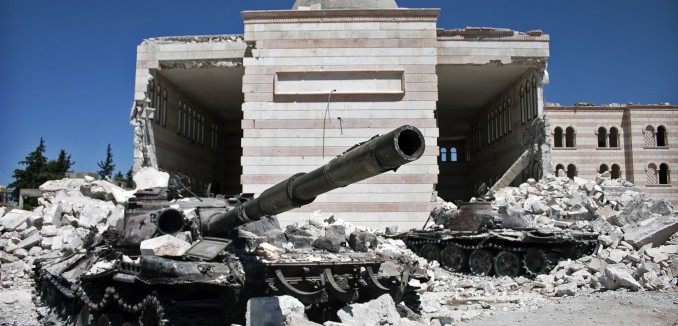Coming on the heels of the Arab Spring, not many believed that the popular protests that erupted in Syria in mid-March 2011 would turn into a prolonged and bloody war that would involve numerous domestic and international players. As the war enters its fifth year with no sign on the horizon for resolution, it would be useful to consider how the conflict started, how it progressed, and what we can expect going forward.
The Syrian civil war began with demonstrations that took place in the city of Daraa in March 2011, following the arrest and torture of young boys who spray-painted a revolutionary slogan on the wall of a school. In the atmosphere of the Arab Spring, opposition elements took advantage of this event and began demonstrating against the regime of Bashar al-Assad, which forcibly dispersed the demonstrations.
With Assad rejecting any move to weaken his iron-clad grip on the country, the demonstrations—and resulting government crackdown—quickly degenerated into civil war that expanded to many cities. In 2012, rebel forces had some notable successes and took control of several cities and suburbs near Damascus and Aleppo. However, in 2013 the Syrian army, assisted by Hezbollah and the Iranian army, began to regain control of its strongholds and exploiting divisions in the ranks of the rebels, especially between the moderate rebels, Kurdish forces, the Islamic State of Iraq and Syria (ISIS) and Jabhat al-Nusra.
The results were disastrous. No side could force a victory and the war in Syria has led to the deaths of at least 210,000 people, and possibly more. About a million people have been injured and over 10 million uprooted and forced to leave their homes. Four million refugees currently reside in neighboring countries such as Turkey, Jordan, Lebanon and Iraq.
Who has control and where?
After four years of crisis, Syria is now divided into five groups of armed forces: the Syrian regime and its allies, ISIS, Jabhat al-Nusra (al-Qaeda’s arm in Syria), the Free Syrian Army factions, and Kurdish forces.
The Syrian army controls the capital of Damascus, the major cities of Hama and Homs, and the Syrian coastal strip. The moderate Syrian opposition has control of some areas of southern Syria and near the border with Israel, and has a massive presence around the northern city of Aleppo, where it is involved in ongoing fierce battles with the Syrian army.
ISIS mainly controls the northeastern region (the cities of Raqqa, Deir ez-Zor and Haska) and a significant part of the eastern border with Iraq. Recently it lost control in Kobane, a northern Kurdish city near the border with Turkey. Kurdish forces, who control of the northern regions along the Turkish border, reconquered the city after a long battle. Jabhat al-Nusra is not concentrated in one place and is devoid of a unified leadership. It controls different, small areas in the northern city of Idlib and southern province of Quneitra.
Bashar al-Assad continues to survive
Commentators in the Arab world and the West believe (Arabic link) that four years after the riots that led to the war, President Bashar al-Assad remains as stronger as ever. He succeeded, with strong regional and international support, in preventing the collapse of his regime, and has maintained control over most of the main cities in Syria, especially the capital Damascus. He was able to cast the conflict not as a popular revolution against a dictatorial regime which aims to achieve freedom and democracy, but as a bloody regional war against terrorist organizations.
Assad enjoys the fact that the international media and major governments today focus largely on the brutality of terrorist groups such as ISIS, ignoring the similarly barbarous acts of his own forces.
Assad is getting massive support from the Russian government, which transfers weapons to the Syrian military on a frequent basis. Iran also helps the Syrian regime by sending funds and fighters. In light of this aid, analysts believe (Arabic link) that the Syrian regime will continue to stay in power, at least in the near term.
In addition, despite its many casualties and desertions from its ranks, the Syrian army remains very strong. It is assisted by battalions called “national defense forces” trained in the past two years by Iranian and Hezbollah personnel. These battalions assisted Assad’s forces in many battles, along with other foreign fighters who support the regime.
The Syrian regime also enjoys the fact that ISIS, which controls large areas in Syria, operates under entirely different objectives and goals from the Syrian moderate opposition. The terror group aims to enact the rule of an Islamic Caliphate, and kills anyone who is not willing to accept its terms. These strategic differences have led to several clashes between opposition factions. Analysts predict that the future holds more conflicts of this kind.
After years of inaction, the West is currently starting to train Syrian opposition factions, but these forces will not be able to create a significant change on the ground, and only direct the coalition’s air raids against ISIS targets and take over relatively small geographical areas. The lack of funding and assistance and the decline in morale in the ranks of the moderate Syrian opposition has led to a significant decline in its influence and power.
Given the number of forces and governments involved, it is unlikely that Syria’s civil war will end any time soon. Even a rare agreement among several actors within the conflict will not necessarily lead to an end, as other groups may still oppose it. Therefore, 2015 is expected to be, unfortunately, another year of bloody Syrian war.
[Photo: Christiaan Triebert, Flickr Photo, CC 2.0]




